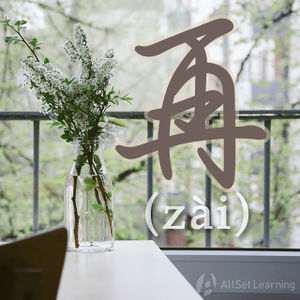Difference between revisions of "Sequencing with "xian" and "zai""
| Line 27: | Line 27: | ||
</div> | </div> | ||
| − | == Using 再说 | + | == Using 先 with 再说 == |
| − | You may have learned that [["In addition" with "zaishuo"|"再说" can mean "in addition."]] Well, this usage of 再 is a more literal combination of | + | You may have learned that [["In addition" with "zaishuo"|"再说" can mean "in addition."]] Well, this usage of 再 is a more literal combination of 再说, fitting into the 先⋯⋯再⋯⋯ pattern. |
So in this usage, 再说 doesn't really mean "in addition." Rather, it most literally means "and then we'll talk." In other words, "let's just do this now," and then after we see the result, we can talk some more about next steps. There's kind of a "let's see how this goes first" feeling to the expression. | So in this usage, 再说 doesn't really mean "in addition." Rather, it most literally means "and then we'll talk." In other words, "let's just do this now," and then after we see the result, we can talk some more about next steps. There's kind of a "let's see how this goes first" feeling to the expression. | ||
| Line 55: | Line 55: | ||
</div> | </div> | ||
| − | == 然后 and 接着 == | + | == Using 然后 and 接着 with 先 == |
| + | 当描述一系列前后关联的行为步骤或事件发生的过程时,你需要用到更丰富的连词。"然后"是最常用的,表示"and then";"接着"作为连词表示"next, afterwards"。跟"然后"比,"接着"还可以作为副词,表示"动作的继续",如"接着做,接着说"。 | ||
| + | |||
| + | A great example to help you understand this: | ||
| + | |||
| + | <div class="liju"> | ||
| + | |||
| + | *今 早 我 起床 以后 <em>先</em> 准备 早饭,<em>再</em> 叫 孩子们 起床,<em>接着</em> 我们 一起 吃早饭,<em>然后</em> 我 送 他们 去 学校 。<span class="pinyin">Jīn zǎo wǒ qǐchuáng yǐhòu <em>xiān</em> zhǔnbèi zǎofàn, <em>zài</em> jiào háizi men qǐchuáng, <em>jiēzhe</em> wǒmen yīqǐ chī zǎofàn, <em>ránhòu</em> wǒ sòng tāmen qù xuéxiào.</span><span class="trans">After I got up this morning, I first prepared breakfast, and then I woke up the kids. Afterwards, we ate breakfast together. After that, I took them to school. </span> | ||
| + | |||
| + | </div> | ||
== Sources and further reading == | == Sources and further reading == | ||
Revision as of 02:44, 29 June 2017
-
Level
-
Similar to
-
Used for
-
Keywords
The word 再 (zài) actually has a lot of uses, beyond just "again." "先⋯⋯, 再⋯⋯" (xiān..., zài...) is a pattern used for sequencing events, much like "First..., then..." in English. This pattern can also include "然后" (ránhòu) meaning "and after that."
Contents
General Usage
In the pattern below, 再 has a meaning of "then" or "and then."
Structure
先 + [Verb Phrase 1] + 再 + [Verb Phrase 2]
Examples
- 先 洗 手 再 吃。Wash your hands, and then eat.
- 我 喜欢 先 洗澡,再 睡觉。I prefer to take a bath before I go to bed.
- 请 你 先 买 票 再 进。Please buy a ticket first, and then you come in.
- 你 要 先 做 作业再 看 电视。First you need to do your homework, and then you can watch.
- 你 先 找 工作 再 考虑 买 房子。First find a job, then you can think about buying a house.
Using 先 with 再说
You may have learned that "再说" can mean "in addition." Well, this usage of 再 is a more literal combination of 再说, fitting into the 先⋯⋯再⋯⋯ pattern.
So in this usage, 再说 doesn't really mean "in addition." Rather, it most literally means "and then we'll talk." In other words, "let's just do this now," and then after we see the result, we can talk some more about next steps. There's kind of a "let's see how this goes first" feeling to the expression.
Structure
Note that in the pattern below, the sentence normally ends with 再说.
先 + [Verb Phrase] + 再说
Examples
- 先 吃饭 再说 。Let's eat first, then we'll talk.
- 先 休息 一下 再说 。Let's rest a little first, then talk.
- 你 先 看 完再说 。Finish reading first, and then we can talk.
- 我 先 问 一下 老板 再说 。I'm going to ask the boss first.
- 你们 先 讨论 一下 再说 。You guys discuss a little first, then we'll talk.
Using 然后 and 接着 with 先
当描述一系列前后关联的行为步骤或事件发生的过程时,你需要用到更丰富的连词。"然后"是最常用的,表示"and then";"接着"作为连词表示"next, afterwards"。跟"然后"比,"接着"还可以作为副词,表示"动作的继续",如"接着做,接着说"。
A great example to help you understand this:
- 今 早 我 起床 以后 先 准备 早饭,再 叫 孩子们 起床,接着 我们 一起 吃早饭,然后 我 送 他们 去 学校 。After I got up this morning, I first prepared breakfast, and then I woke up the kids. Afterwards, we ate breakfast together. After that, I took them to school.
Sources and further reading
Books
- Integrated Chinese: Level 1, Part 1 (3rd ed) (pp. 258-9) →buy
- Integrated Chinese: Level 2, Part 2 (pp. 19-20) →buy
- 卓越汉语-公司实战篇 (p. 172) →buy



